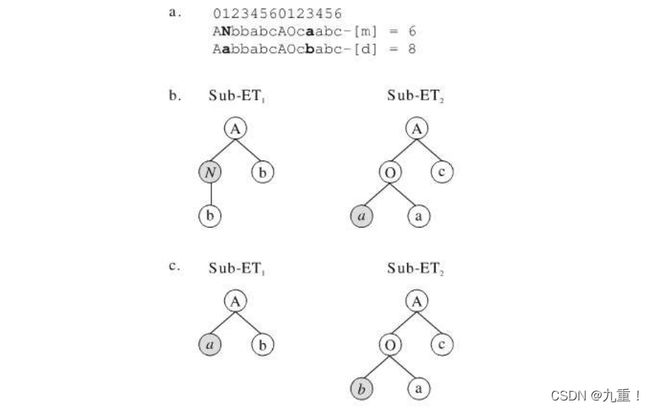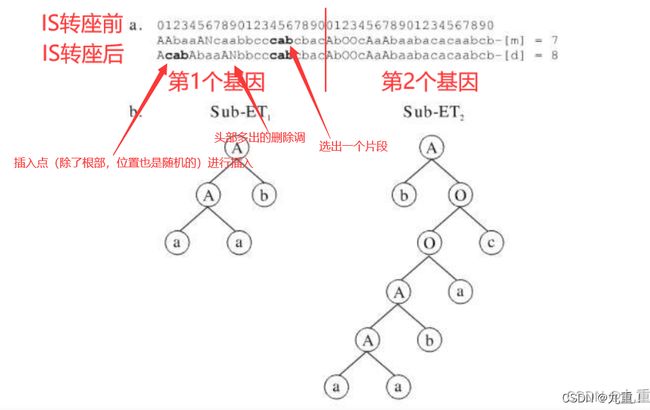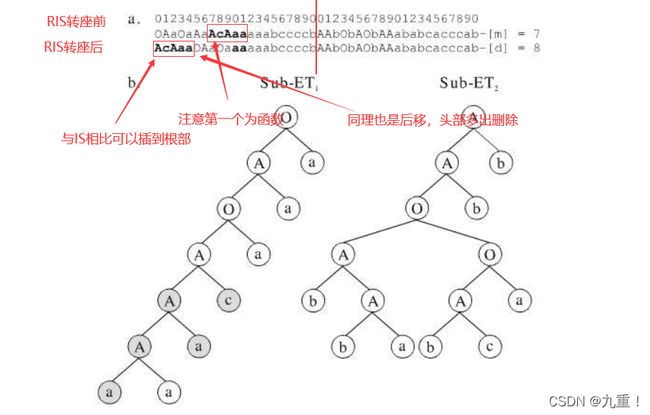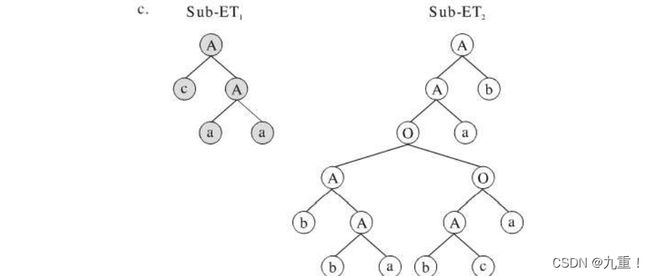基因表达式编程(GEP)自学 第【6】天 Python 实现(代码)
目录
- 1. 基因表达式编程 GEP Python 代码实现【★★★★★】
- 2. 轮盘赌算法 实现染色体的选择
-
- 2.1. 基本思想:
- 2.2. 代码实现:
- 3. 染色体 复制更新
- 4. 染色体修饰
-
- 4.1 Environment 类:
- 4.2. Chromosome类:
-
- 4.2.1. 突变 mutation
- 4.2.2 IS转座 ISTransposition
- 4.2.2 RIS转座 RISTransposition
- 4.2.3 基因转座 geneTransposition
- 4.2.4 单点重组 onePointRecombination
- 4.2.5 两点重组 twoPointRecombination
- 4.2.5 基因重组 geneRecombination
- 5. 打印染色体
- 6. 将以上功能更新到run上
- 6. 输出测试
- 7. 代码实现整合
1. 基因表达式编程 GEP Python 代码实现【★★★★★】
今天将用python实现GEP算法中,染色体选择,复制,变异等的内容
【PS:注意结合前边内容,今天的内容比较多,包括染色体选择、复制、变异等内容,需要对GEP的基本知识内容认识。】
基因表达式编程(GEP)自学 第【1】天 Python 实现
基因表达式编程(GEP)自学 第【2】天 Python 实现
基因表达式编程(GEP)自学 第【3】天 Python 实现
基因表达式编程(GEP)自学 第【4】天 Python 实现(代码)
基因表达式编程(GEP)自学 第【5】天 Python 实现(代码)
2. 轮盘赌算法 实现染色体的选择
2.1. 基本思想:
个体被选中的概率与其适应度函数值成正比
设群体大小为n,个体i的适应度为Fi,则个体i被选中遗传到下一代群体的概率为

设想群体全部个体的适当性分数由一张饼图来代表 ,如下图:

群体中每一染色体指定饼图中一个小块。块的大小与染色体的适应性分数成比例,适应性分数愈高,它在饼图中对应的小块所占面积也愈大。为了选取一个染色体,要做的就是旋转这个轮子,直到轮盘停止时,看指针停止在哪一块上,就选中与它对应的那个染色体。

2.2. 代码实现:
Environment 类:
def select(self, sum_fitness,NowBestChromosome):
'''
:param sum_fitness: 总的适应度
:param NowBestChromosome: 用于保存当代最佳染色体
:return: selected 用于保存赌盘选择出的染色体
'''
accumulator = 0 # 设置累加器
roulette=[] # 设置轮盘
selected=[]
#制作赌盘,如果percentage 区间为0的
for i in range(len(self.population)):
percentage = self.population[i][1] / sum_fitness * 10
if percentage != 0:
roulette.append(percentage + accumulator)
accumulator = accumulator + percentage
else:
roulette.append(0)
#一共选择 len(self.population)-1 条染色体体,最后一条保存最佳染色体。
for i in range(len(self.population)-1):
#产生随机数
ranNumber=random.uniform(0,10)
#进行选择染色体
for i_pos in range(len(self.population)):
if ranNumber <= roulette[i_pos]:
selected.append(self.population[i_pos][0])
break
#最后一条保存最佳染色体
selected.append(NowBestChromosome)
return selected
3. 染色体 复制更新
PS: 将赌盘后选择种群染色体,进行染色体复制,保证更新在 self.population
Environment 类:
def replicate(self, chromosomes):
'''
进行染色体复制,保证更新在 self.population
:param chromosomes: 赌盘后选择种群染色体
:return:
'''
self.population = []
for chromosome in chromosomes:
self.population.append(chromosome.replicate())
Chromosome 类:
def replicate(self):
'''
基因复制
newGenes 保存新的基因
newHomeotics 保存新的连接基因
newChromosome 创建新的染色体,并赋值
:return: newChromosome 返回新的染色体
'''
newGenes = []
newHomeotics = []
# 基因复制
for gene in self.genes:
newGenes.append(gene.replicate())
# 连接基因复制
for homeotic in self.homeotics:
newHomeotics.append(homeotic.replicate())
# 创建新的染色体
newChromosome = Chromosome()
newChromosome.genes = newGenes
newChromosome.homeotics = newHomeotics
return newChromosome
Gene 类:
def replicate(self):
'''
创建新的基因,并对基因内的元素进行复制
:return: newGene 返回新的基因
'''
newGene = Gene(self.genome, self.homeotic_flag)
newGene.head = self.head[:]
newGene.tail = self.tail[:]
return newGene
4. 染色体修饰
包括:
- mutation: 突变
- ISTransposition IS转座
- RISTransposition RIS转座
- geneTransposition 基因转座
- onePointRecombination 单点重组
- twoPointRecombination 两点重组
- geneRecombination 基因重组
4.1 Environment 类:
def modify(self):
'''
染色体修饰
mutation: 突变
ISTransposition IS转座
RISTransposition RIS转座
geneTransposition 基因转座
onePointRecombination 单点重组
twoPointRecombination 两点重组
geneRecombination 基因重组
:return:
'''
for i in range(len(self.population)):
chromosome = self.population[i]
chromosome.mutation(self.mutationRate, self.homeoticRate)
chromosome.ISTransposition(self.ISTranspositionRate, self.homeoticRate)
chromosome.RISTransposition(self.RISTranspositionRate, self.homeoticRate)
chromosome.geneTransposition(self.geneTranspositionRate, self.homeoticRate)
#选择于i不同的染色体的,otherIndex
otherIndex = i
while otherIndex == i:
otherIndex = random.randint(0, len(self.population) - 1)
chromosome.onePointRecombination(self.onePointRecombinationRate, self.homeoticRate, self.population[otherIndex])
otherIndex = i
while otherIndex == i:
otherIndex = random.randint(0, len(self.population) - 1)
chromosome.twoPointRecombination(self.twoPointRecombinationRate, self.homeoticRate, self.population[otherIndex])
otherIndex = i
while otherIndex == i:
otherIndex = random.randint(0, len(self.population) - 1)
chromosome.geneRecombination(self.geneRecombinationRate, self.homeoticRate, self.population[otherIndex])
4.2. Chromosome类:
4.2.1. 突变 mutation
变异(突变)可以发生在染色体内的任何位置。然而,染色体的结构组织必须保持完整。所以在头部中,任何符号都可以变成符号或者终点;在尾部中,终点只能够变成终点。通过这种方法,染色体的结构组织得以保持,而且由变异产生的新个体是结构上正确的程序。

def mutation(self, rate, homeoticRate):
'''
:param rate: 基因突变的概率
:param homeoticRate: 连接基因突变的概率
:return:
head: 保存基因头部
tail 保存基因尾部
functions 保存操作符如:【“+”,“-”,“*”,“/”】
'''
for gene in self.genes:
head = gene.head
tail = gene.tail
functions = list(gene.genome.functions.keys())
functions.pop(functions.index("max_arity"))
# 基因头部突变
for i in range(len(head)):
if random.random() < rate:
head[i] = random.choice(functions + gene.genome.terminals)
# 基因尾部突变
for i in range(len(tail)):
if random.random() < rate:
tail[i] = random.choice(gene.genome.terminals)
#连接基因的突变为 rate = homeoticRate*rate
rate *= homeoticRate
for homeotic in self.homeotics:
head = homeotic.head
tail = homeotic.tail
functions = list(homeotic.genome.functions.keys())
functions.pop(functions.index("max_arity"))
# 连接基因头部突变,突变的选择有些不同:functions + list(range(len(self.genes)))
for i in range(len(head)):
if random.random() < rate:
head[i] = random.choice(functions + list(range(len(self.genes))))
# 连接基因尾部部突变
for i in range(len(tail)):
if random.random() < rate:
tail[i] = random.randint(0, len(self.genes) - 1)
4.2.2 IS转座 ISTransposition
【PS:IS转座是从种群中随机选择一个染色体,然后随机从IS转座长度中选择IS长度,然后在染色体中选择IS长度的基因片段,并随机选择基因,插入到除基因首元素之外的头部部分中】


def ISTransposition(self, rate, homeoticRate):
'''
IS转座是从种群中随机选择一个染色体,然后随机从IS转座长度中选择IS长度,
然后在染色体中选择IS长度的基因片段,并随机选择基因,插入到除基因首元素之外的头部部分中。
:param rate: 基因IS概率
:param homeoticRate: 连接基因IS概率
:return:
seq 将所有基因进行连接保存
start 选择一小段的起点
stop 选择一小段的终点
ISSeq 保存选出的小段
insertPoint 插入点
'''
# 出现IS转座
if random.random() < rate:
seq = []
for gene in self.genes:
seq = seq + gene.head + gene.tail
# 随机选择一个基因
gene = random.choice(self.genes)
headLength = len(gene.head)
# 选择截取一小断保存在 ISSeq 中
start = random.randint(0, len(seq) - 1)
stop = random.randint(start, start + headLength)
ISSeq = seq[start:stop + 1]
# 选择一个插入点,进行插入,并且去掉超过长度的部分
insertPoint = random.randint(1, headLength - 1)
for i in range(len(ISSeq)):
gene.head.insert(insertPoint + i, ISSeq[i])
gene.head = gene.head[:headLength]
#连接基因的IS转座为 rate = homeoticRate*rate
rate *= homeoticRate
if random.random() < rate:
seq = []
for homeotic in self.homeotics:
seq = seq + homeotic.head + homeotic.tail
# 随机选择一个基因
homeotic = random.choice(self.homeotics)
headLength = len(homeotic.head)
# 选择截取一小断保存在 ISSeq 中
start = random.randint(0, len(seq) - 1)
stop = random.randint(start, start + headLength)
ISSeq = seq[start:stop + 1]
insertionPoint = random.randint(1, headLength - 1)
# 选择一个插入点,进行插入,并且去掉超过长度的部分
for i in range(len(ISSeq)):
homeotic.head.insert(insertionPoint + i, ISSeq[i])
homeotic.head = homeotic.head[:headLength]
4.2.2 RIS转座 RISTransposition
【PS:所有的RIS元素都是从一个函数开始,因此是选自头部分中的序列。因此在头中任选一点,沿基因向后查找,直到发现一个函数为止。该函数成为RIS元素的起始位置。如果找不到任何函数,则变换不执行任何操作。该算子随机选取染色体,需要修饰的基因,RIS元素以及其长度。】


def RISTransposition(self, rate, homeoticRate):
'''
:param rate: 基因RIS转座概率
:param homeoticRate: 连接基因RIS转座概率
:return:
seq 将所有基因进行连接保存
functions 保存操作符如:【“+”,“-”,“*”,“/”】
start 选择一小段的起点
end 选择一小段的终点
RISSeq 保存选出的小段
insertPoint 插入点
'''
# 进行RIS转座
if random.random() < rate:
seq = []
for gene in self.genes:
seq = seq + gene.head + gene.tail
# 随机选择一个基因
gene = random.choice(self.genes)
headLength = len(gene.head)
functions = list(gene.genome.functions.keys())
functions.pop(functions.index("max_arity"))
# 选择截取一小断保存在 RISSeq 中
start = random.randint(0, len(seq) - 1)
#直到发现一个函数为止
while seq[start] not in functions:
if start == len(seq) - 1:
break
start += 1
stop = random.randint(start, start + headLength)
RISSeq = seq[start:stop + 1]
#进行插入,并且去掉超过长度的部分
for i in range(len(RISSeq)):
gene.head.insert(i, RISSeq[i])
gene.head = gene.head[:headLength]
#连接基因的RIS转座为 rate = homeoticRate*rate
rate *= homeoticRate
if random.random() < rate:
seq = []
for homeotic in self.homeotics:
seq = seq + homeotic.head + homeotic.tail
# 随机选择一个基因
homeotic = random.choice(self.homeotics)
headLength = len(homeotic.head)
functions = list(homeotic.genome.functions.keys())
functions.pop(functions.index("max_arity"))
# 选择截取一小断保存在 RISSeq 中
start = random.randint(0, len(seq) - 1)
while seq[start] not in functions:
if start == len(seq) - 1:
break
start += 1
stop = random.randint(start, start + headLength)
#进行插入,并且去掉超过长度的部分
RISSeq = seq[start:stop + 1]
for i in range(len(RISSeq)):
homeotic.head.insert(i, RISSeq[i])
homeotic.head = homeotic.head[:headLength]
4.2.3 基因转座 geneTransposition
def geneTransposition(self, rate, homeoticRate):
'''
基因转座仅仅改变基因在同一染色体中的位置
:param rate: 基因转座概率
:param homeoticRate: 连接基因转座概率
:return:
'''
if random.random() < rate:
self.genes[random.randint(0,len(self.genes)-1)] = random.choice(self.genes).replicate()
rate *= homeoticRate
if random.random() < rate:
self.homeotics[random.randint(0,len(self.homeotics)-1)] = random.choice(self.homeotics).replicate()
4.2.4 单点重组 onePointRecombination
进行单点重组的时候,父代染色体相互配对并在相同的位置切断,两个染色体相互交换重组点之后的部分。

def onePointRecombination(self, rate, homeoticRate, otherChromosome):
'''
进行单点重组的时候,父代染色体相互配对并在相同的位置切断,两个染色体相互交换重组点之后的部分
:param rate: 单点重组概率
:param homeoticRate: 连接基因单点重组概率
:param otherChromosome: 染色体
:return:
seq 当前染色体将所有基因进行连接保存
otherSeq 不同于当前染色体将所有基因进行连接保存
recombinationPoint 重组结点
'''
# 进行单点重组
if random.random() < rate:
seq = []
otherSeq = []
for gene in self.genes:
seq = seq + gene.head + gene.tail
for otherGene in otherChromosome.genes:
otherSeq = otherSeq + otherGene.head + otherGene.tail
if len(seq) != len(otherSeq):
return
# 进行单点重组(交换)
recombinationPoint = random.randint(0, len(seq) - 1)
seq[recombinationPoint:], otherSeq[recombinationPoint:] = otherSeq[recombinationPoint:], seq[recombinationPoint:]
# 单点重组后,当前染色体进行保存
for gene in self.genes:
gene.head = seq[:len(gene.head)]
del seq[0:len(gene.head)]
gene.tail = seq[:len(gene.tail)]
del seq[0:len(gene.tail)]
# 单点重组后,不同于当前染色体进行保存
for otherGene in otherChromosome.genes:
otherGene.head = otherSeq[:len(otherGene.head)]
del otherSeq[0:len(otherGene.head)]
otherGene.tail = otherSeq[:len(otherGene.tail)]
del otherSeq[0:len(otherGene.tail)]
#连接基因的单点重组为 rate = homeoticRate*rate
rate *= homeoticRate
if random.random() < rate:
seq = []
otherSeq = []
for homeotic in self.homeotics:
seq = seq + homeotic.head + homeotic.tail
for otherHomeotic in otherChromosome.homeotics:
otherSeq = otherSeq + otherHomeotic.head + otherHomeotic.tail
if len(seq) != len(otherSeq):
return
# 进行单点重组(交换)
recombinationPoint = random.randint(0, len(seq) - 1)
seq[recombinationPoint:], otherSeq[recombinationPoint:] = otherSeq[recombinationPoint:], seq[recombinationPoint:]
# 单点重组后,当前染色体进行保存
for homeotic in self.homeotics:
homeotic.head = seq[:len(homeotic.head)]
del seq[0:len(homeotic.head)]
homeotic.tail = seq[:len(homeotic.tail)]
del seq[0:len(homeotic.tail)]
# 单点重组后,不同于当前染色体进行保存
for otherHomeotic in otherChromosome.homeotics:
otherHomeotic.head = otherSeq[:len(otherHomeotic.head)]
del otherSeq[0:len(otherHomeotic.head)]
otherHomeotic.tail = otherSeq[:len(otherHomeotic.tail)]
del otherSeq[0:len(otherHomeotic.tail)]
4.2.5 两点重组 twoPointRecombination
进行两点重组的时候,父代染色体相互配对,在染色体中随机选择两个点,将染色体切断。两个染色体相互交换重组点之间的部分,形成两个新的子代染色体。

def twoPointRecombination(self, rate, homeoticRate, otherChromosome):
'''
进行两点重组的时候,父代染色体相互配对,在染色体中随机选择两个点,将染色体切断。
两个染色体相互交换重组点之间的部分,形成两个新的子代染色体
:param rate: 两点重组概率
:param homeoticRate: 连接基因两点重组概率
:param otherChromosome: 不同于当前的染色体
:return:
seq 当前染色体将所有基因进行连接保存
otherSeq 不同于当前染色体将所有基因进行连接保存
recombinationPoint 重组结点
otherPoint 另一个重组结点
'''
# 进行两点重组
if random.random() < rate:
seq = []
otherSeq = []
for gene in self.genes:
seq = seq + gene.head + gene.tail
for otherGene in otherChromosome.genes:
otherSeq = otherSeq + otherGene.head + otherGene.tail
if len(seq) != len(otherSeq):
return
# 进行两点重组(交换)
recombinationPoint = random.randint(0, len(seq) - 1)
otherPoint = random.randint(recombinationPoint, len(seq) - 1)
seq[recombinationPoint:], otherSeq[recombinationPoint:] = otherSeq[recombinationPoint:], seq[recombinationPoint:]
seq[:otherPoint], otherSeq[:otherPoint] = otherSeq[:otherPoint], seq[:otherPoint]
# 两点重组后,当前染色体进行保存
for gene in self.genes:
gene.head = seq[:len(gene.head)]
del seq[0:len(gene.head)]
gene.tail = seq[:len(gene.tail)]
del seq[0:len(gene.tail)]
# 两点重组后,不同于当前染色体进行保存
for otherGene in otherChromosome.genes:
otherGene.head = otherSeq[:len(otherGene.head)]
del otherSeq[0:len(otherGene.head)]
otherGene.tail = otherSeq[:len(otherGene.tail)]
del otherSeq[0:len(otherGene.tail)]
#连接基因的两点重组为 rate = homeoticRate*rate
rate *= homeoticRate
# 进行两点重组
if random.random() < rate:
seq = []
otherSeq = []
for homeotic in self.homeotics:
seq = seq + homeotic.head + homeotic.tail
for otherHomeotic in otherChromosome.homeotics:
otherSeq = otherSeq + otherHomeotic.head + otherHomeotic.tail
if len(seq) != len(otherSeq):
return
# 进行两点重组(交换)
recombinationPoint = random.randint(0, len(seq) - 1)
otherPoint = random.randint(recombinationPoint, len(seq) - 1)
seq[recombinationPoint:], otherSeq[recombinationPoint:] = otherSeq[recombinationPoint:], seq[recombinationPoint:]
seq[:otherPoint], otherSeq[:otherPoint] = otherSeq[:otherPoint], seq[:otherPoint]
# 两点重组后,当前染色体进行保存
for homeotic in self.homeotics:
homeotic.head = seq[:len(homeotic.head)]
del seq[0:len(homeotic.head)]
homeotic.tail = seq[:len(homeotic.tail)]
del seq[0:len(homeotic.tail)]
# 两点重组后,不同于当前染色体进行保存
for otherHomeotic in otherChromosome.homeotics:
otherHomeotic.head = otherSeq[:len(otherHomeotic.head)]
del otherSeq[0:len(otherHomeotic.head)]
otherHomeotic.tail = otherSeq[:len(otherHomeotic.tail)]
del otherSeq[0:len(otherHomeotic.tail)]
4.2.5 基因重组 geneRecombination
在 GEP 的第三种重组中,两个染色体中的整个基因相互交换,形成的两个子代染色体含有来自两个父体的基因。

def geneRecombination(self, rate, homeoticRate, otherChromosome):
'''
在 GEP 的第三种重组中,两个染色体中的整个基因相互交换,
形成的两个子代染色体含有来自两个父体的基因。
:param rate: 基因重组概率
:param homeoticRate: 连接基因重组概率
:param otherChromosome: 不同于当前的染色体
:return:
'''
# 进行基因重组
if random.random() < rate:
if len(self.genes) != len(otherChromosome.genes):
return
recombinationPoint = random.randint(0, len(self.genes) - 1)
self.genes[recombinationPoint:recombinationPoint+1], otherChromosome.genes[recombinationPoint:recombinationPoint+1] = otherChromosome.genes[recombinationPoint:recombinationPoint+1], self.genes[recombinationPoint:recombinationPoint+1]
#连接基因的基因重组为 rate = homeoticRate*rate
rate *= homeoticRate
if random.random() < rate:
if len(self.homeotics) != len(otherChromosome.homeotics):
return
recombinationPoint = random.randint(0, len(self.homeotics) - 1)
self.homeotics[recombinationPoint:recombinationPoint+1], otherChromosome.homeotics[recombinationPoint:recombinationPoint+1] = otherChromosome.homeotics[recombinationPoint:recombinationPoint+1], self.homeotics[recombinationPoint:recombinationPoint+1]
5. 打印染色体
Chromosome 类
def printChromosome(self):
for gene in self.genes:
print(gene.head + gene.tail, end=':\n')
for homeotic in self.homeotics:
print(homeotic.head + homeotic.tail, end=';\n')
print()
6. 将以上功能更新到run上
Environment类:
def run(self, inputsOutputs, evalFunction,generationCount=200,M=100,DataCount=10):
'''
:param inputsOutputs: 保存输入与输出集合
:param evalFunction: 适应度函数
:param generationCount: 执行代数
:return:
generation: 表示第几代种群
i_chromosome 用于保存当代种群第i条染色体
C_valueList 表示染色体,样本输出值
fitness 保存当前染色体的适应度
maxFitness_flag=True 为True,返回的maxFitness:M*DataCount
'''
ResultBestFitness=float("-inf")
ResultBestChromosome=[]
generation = 0
while True:
sum_fitness=0
NowBestFitness=float("-inf")
NowBestChromosome=[]
#进行种群打印
print("generation: ",generation)
# 可以打印每一染色出来看。。。
# self.printChromosomes(generation)
generation += 1
for i in range(len(self.population)):
C_valueList = []
i_chromosome = self.population[i]
#计算每个染色体对应的 C_value
# print(inputsOutputs[0])
for inputs in inputsOutputs[0]:
C_valueList.append(i_chromosome.eval(inputs))
#evalFunction 进行适应度评估
fitness = evalFunction(C_valueList, inputsOutputs[1], M=M, DataCount=DataCount)
sum_fitness=sum_fitness+fitness
#保存当代种群最佳适应度的值,与对应的染色体
if fitness > NowBestFitness:
NowBestFitness = fitness
NowBestChromosome=i_chromosome
# 完美解停止执行
if fitness == evalFunction([], [], maxFitness_flag=True,M=M,DataCount=DataCount):
print("*" * 46, " 完美解 ", "*" * 46)
i_chromosome.printChromosome()
return i_chromosome
##-----输出测试-----##
# print("[",i,"] "," Fitness=",fitness)
####----------输出测试----------####
self.population[i] = (i_chromosome, fitness)
# 打印当代最佳染色体
print("NowBestFitness=",NowBestFitness)
NowBestChromosome.printChromosome()
print("*"*46)
# 保存最终最佳解,与对应的染色体
if ResultBestFitness<NowBestFitness:
ResultBestFitness=NowBestFitness
ResultBestChromosome=NowBestChromosome
# 繁衍代数大于generationCount退出, 并输出最佳解
if generation >= generationCount:
print("*"*46," ",generationCount,"代后最佳解 ","*"*46)
print("result_fitness= ", ResultBestFitness)
ResultBestChromosome.printChromosome()
return ResultBestChromosome
selected=self.select(sum_fitness,NowBestChromosome)
self.replicate(selected)
self.modify()
self.population[0]=NowBestChromosome
6. 输出测试
if __name__=='__main__':
#---------------操作数设置 Begin--------------#
genome = Genome()
genome.functions.update(Genome.linker_set)
genome.terminals = ['a','b']
genome.symbols()
my_link_genome=Genome()
my_link_genome.functions.update(Genome.linker_set)
#----------------操作数设置 end---------------#
#---------------种群初始化 Begin--------------#
environment = Environment()
environment.init(populationSize=20,numGenes=3,numHomeotics=1,headLength=4,homeoticHeadLength=5,genome=genome,link_genome=my_link_genome)
environment.setRates(homeoticRate=0.5, mutationRate=0.044,ISTranspositionRate=0.1,
RISTranspositionRate=0.1, geneTranspositionRate=0.1,onePointRecombinationRate=0.3,
twoPointRecombinationRate=0.3, geneRecombinationRate=0.1)
# ##----------输出测试----------##
#----------------种群初始化 end---------------#
#---------------Run Begin--------------#
M=100
DataCount=10
generationCount=1000
inputsOutputs=GenerateData(DataCount=DataCount)
result=environment.run(inputsOutputs,evalFunction,M=M,generationCount=generationCount)
#----------------Run end---------------#
输出结果:
部分结果
**********************************************
generation: 999
0 :['b', 'b', 'a', 'a', 'a', 'b', 'b', 'b', 'b']:['+', '+', '+', 'b', 'b', 'b', 'a', 'a', 'b']:['+', '+', 'b', '+', 'a', 'a', 'a', 'a', 'a']:['+', 1, '+', '+', 1, 1, 0, 0, 0, 1, 2]:
1 :['*', '+', '+', '+', 'a', 'b', 'b', 'b', 'b']:['+', 'a', 'b', 'b', 'b', 'a', 'a', 'b', 'a']:['+', '+', '+', 'a', 'a', 'a', 'a', 'a', 'a']:[1, 0, '+', 1, '+', 1, 2, 0, 0, 1, 2]:
2 :['+', '+', '+', '/', 'a', 'b', 'a', 'b', 'b']:['+', '+', 'a', 'b', 'b', 'b', 'a', 'a', 'b']:['+', '+', '+', 'a', 'a', 'a', 'a', 'a', 'a']:[0, '+', 0, '-', 0, 1, 2, 2, 0, 0, 0]:
3 :['+', 'a', '/', 'a', 'a', 'b', 'b', 'b', 'b']:['b', 'b', '/', 'a', 'b', 'a', 'a', 'a', 'a']:['+', 'a', 'b', 'a', 'a', 'b', 'b', 'b', 'a']:['+', 0, '/', 0, 1, 1, 2, 2, 0, 0, 0]:
4 :['*', '+', '+', '+', 'a', 'b', 'a', 'b', 'b']:['+', '+', 'a', '+', 'b', 'a', 'a', 'a', 'b']:['+', 'b', '+', '/', 'a', 'a', 'a', 'a', 'b']:[0, '+', 0, '-', 0, 1, 2, 2, 0, 0, 0]:
5 :['/', '*', 'a', 'a', 'a', 'b', 'b', 'b', 'b']:['/', 'a', 'b', 'b', 'a', 'b', 'b', 'b', 'b']:['a', 'a', 'b', '+', 'b', 'b', 'a', 'a', 'a']:['+', 0, '+', 0, 2, 1, 2, 2, 0, 0, 0]:
6 :['*', 'a', 'a', '/', 'a', 'b', 'b', 'b', 'b']:['*', 'a', 'a', 'a', 'a', 'b', 'b', 'a', 'b']:['+', 'b', '+', '+', 'b', 'b', 'b', 'a', 'a']:[2, 1, '+', 0, 0, 1, 2, 1, 0, 1, 0]:
7 :['+', '-', 'a', 'b', 'a', 'a', 'a', 'b', 'b']:['b', 'b', '/', '/', 'b', 'a', 'a', 'a', 'b']:['+', '+', '+', '+', 'a', 'a', 'a', 'a', 'a']:[0, '+', 2, '+', 0, 1, 2, 2, 2, 0, 0]:
8 :['+', '-', 'a', 'b', 'a', 'a', 'a', 'b', 'b']:['b', 'b', '/', 'a', 'b', 'a', 'a', 'a', 'a']:['+', '+', '+', '/', 'a', 'a', 'b', 'b', 'b']:['+', 0, '+', 0, 2, 1, 2, 2, 0, 0, 0]:
9 :['+', '+', 'a', 'b', 'a', 'a', 'a', 'b', 'a']:['+', 'a', 'a', 'a', 'b', 'a', 'a', 'b', 'b']:['+', '+', '+', '+', 'a', 'a', 'b', 'a', 'a']:['+', 1, '+', 1, 0, 1, 0, 0, 0, 1, 0]:
10 :['+', 'a', 'a', '-', 'a', 'b', 'a', 'b', 'b']:['+', '+', 'a', 'b', 'b', 'b', 'a', 'a', 'b']:['+', '+', '+', '/', 'a', 'a', 'b', 'b', 'b']:['+', 1, 2, '+', 0, 1, 2, 2, 0, 0, 0]:
11 :['+', 'a', 'a', '-', 'a', 'b', 'a', 'b', 'b']:['+', '+', 'a', 'b', 'b', 'a', 'a', 'a', 'b']:['+', '+', '+', '/', 'a', 'a', 'b', 'b', 'b']:['+', 1, 2, '+', 0, 1, 2, 0, 0, 0, 0]:
12 :['+', 'a', 'a', '-', 'a', 'b', 'b', 'b', 'b']:['+', 'a', 'b', 'a', 'b', 'b', 'a', 'b', 'a']:['+', '+', '+', '/', 'a', 'a', 'b', 'b', 'b']:['+', 1, 2, '+', 0, 1, 2, 2, 0, 0, 0]:
13 :['-', '+', 'b', 'b', 'b', 'a', 'a', 'b', 'a']:['a', '+', '/', 'a', 'b', 'b', 'a', 'a', 'a']:['+', '+', '+', '/', 'a', 'a', 'b', 'b', 'b']:['+', 0, '+', 0, '+', 1, 2, 2, 0, 1, 0]:
14 :['+', 'a', 'a', 'a', 'a', 'b', 'a', 'b', 'b']:['a', '+', 'b', 'a', 'a', 'b', 'a', 'b', 'b']:['+', '+', 'b', '+', 'b', 'a', 'b', 'a', 'a']:[2, 1, '+', 0, 0, 1, 2, 1, 0, 1, 2]:
15 :['+', '+', '/', 'a', 'a', 'b', 'b', 'b', 'b']:['b', 'b', 'b', 'b', 'b', 'b', 'a', 'a', 'b']:['a', '+', '+', '+', 'b', 'a', 'b', 'b', 'b']:[0, '+', 0, '+', 2, 1, 0, 0, 0, 2, 0]:
16 :['+', '+', '+', '/', 'b', 'b', 'a', 'b', 'b']:['+', '+', 'a', '+', 'b', 'a', 'a', 'b', 'b']:['a', '+', 'b', '+', 'a', 'a', 'a', 'a', 'b']:[0, '+', 1, '+', 0, 1, 0, 0, 2, 1, 0]:
17 :['+', 'a', 'a', '-', 'a', 'b', 'a', 'b', 'b']:['+', '+', 'a', 'b', 'b', 'b', 'a', 'b', 'b']:['+', '+', '+', '/', 'a', 'a', 'b', 'b', 'b']:['+', 1, 2, '+', 0, 1, 2, 2, 0, 0, 0]:
18 :['b', '+', 'a', 'b', 'a', 'a', 'b', 'b', 'b']:['b', 'b', 'b', 'a', 'a', 'a', 'a', 'a', 'b']:['*', 'a', '/', 'a', 'a', 'a', 'a', 'a', 'b']:[0, 0, '+', 0, '+', 1, 0, 0, 0, 1, 2]:
19 :['+', '*', '+', 'a', 'a', 'a', 'a', 'b', 'b']:['+', 'a', 'a', 'a', 'b', 'a', 'a', 'b', 'b']:['+', '+', '+', 'a', 'a', 'a', 'b', 'b', 'b']:['+', 1, '+', 1, 0, 1, 0, 2, 0, 0, 0]:
NowBestFitness= 906
['*', '+', '+', '+', 'a', 'b', 'a', 'b', 'b']:
['+', '+', 'a', '+', 'b', 'a', 'a', 'a', 'b']:
['+', 'b', '+', '/', 'a', 'a', 'a', 'a', 'b']:
[0, '+', 0, '-', 0, 1, 2, 2, 0, 0, 0];
********************************************** 1000 代后最佳解 **********************************************
result_fitness= 988.0
['+', '+', 'b', 'a', 'a', 'a', 'b', 'b', 'b']:
['a', '+', '/', 'a', 'b', 'a', 'b', 'a', 'b']:
['+', '+', '*', '/', 'b', 'a', 'b', 'b', 'b']:
['+', '+', '+', '+', '+', 0, 0, 0, 1, 2, 2];
7. 代码实现整合
为了方便演示,我将每个类整合到一个py文件上,GEP-6 复制修饰实现(GEP基本实现了)
本文作者:九重!
本文链接:https://blog.csdn.net/weixin_43798572/article/details/122860091
关于博主:评论和私信会在第一时间回复。或者直接私信我。
声援博主:如果您觉得文章对您有帮助,可以点击文章右下角【点赞】【收藏】一下。您的鼓励是博主的最大动力!
